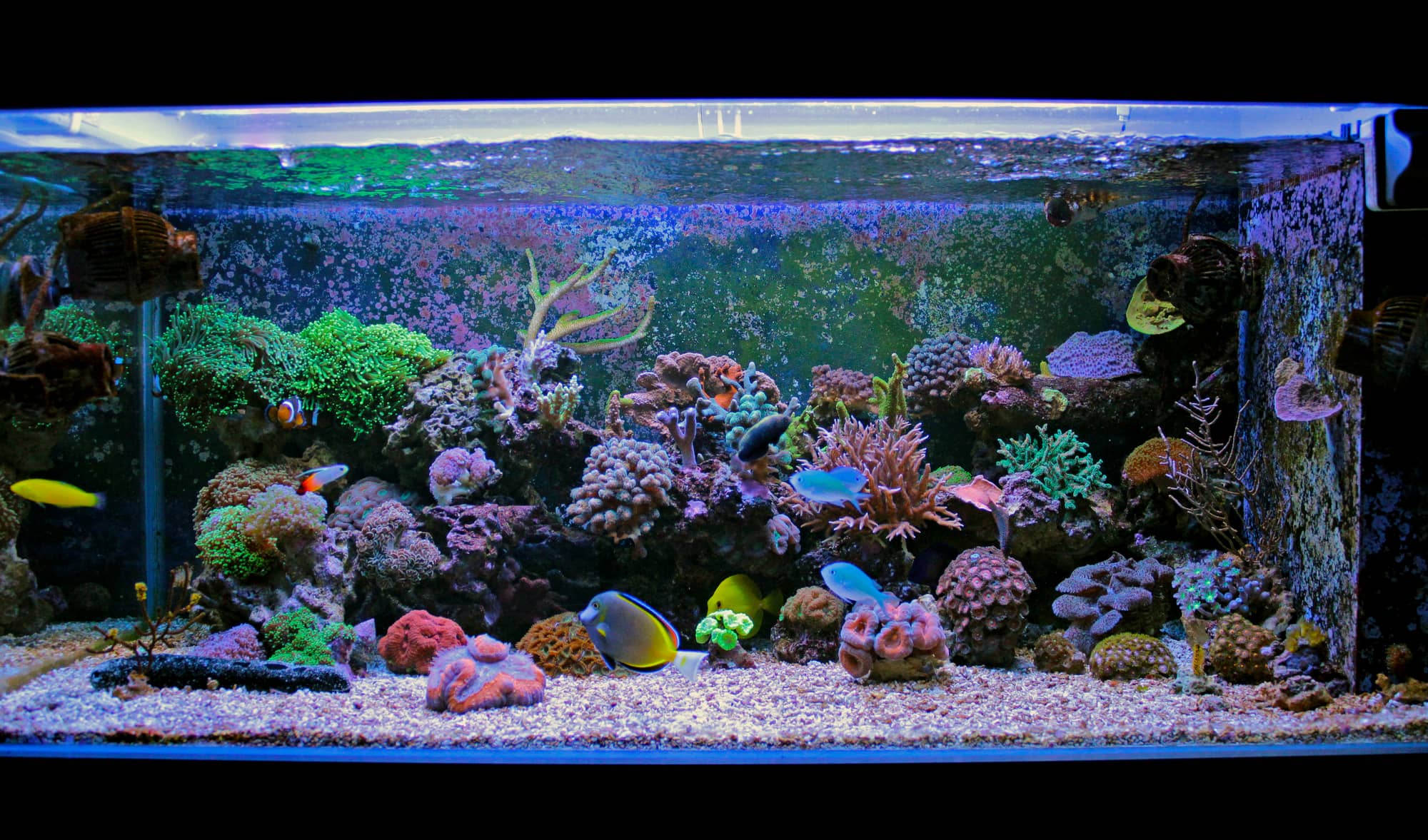
The first step to having a successful reef tank is having good saltwater. Most nutrients needed in a reef aquarium are a combination of those naturally occurring in water being used and those supplemented by additional salt.
Because of this, some reef salts provide better nutrient levels for your tank. You’ll also want a safe, easy-to-use product that dissolves entirely.
Keep reading to find out everything you need to know about reef salt, why you need it, and how it works in your own saltwater aquarium.
What is reef salt?
In short, reef salt is used to make homemade saltwater, which simulates the composition of seawater in the natural marine environment saltwater fish need. This is the best alternative for hobbyists who don’t have a readily available source of real seawater for their reef tank.
There are many brands of reef salt available, at every price point, and all offer a different formula. One mixture might work for one tank while another might need something different.
No matter which brand you choose for your reef salt mix, the goal of the product is the same: a stable tank with parameters meeting ideal ranges according to your personal setup. This is achieved through different formulas of natural minerals.
As a salt, the main ingredients of salt mixes are sodium (Na) and chloride (Cl). From there, each brand will have its own mix that gives different results concerning both major and minor elements.
For example, one reef salt may guarantee an alkalinity level of 8.0 dKH while another one will mix 8.5 dKH. Though these differences might seem insignificant, a healthy environment relies on precise ratios, and the balance of alkalinity can greatly affect how a system runs and might bring the extra growth or color that your coral reef has been missing.
How to mix saltwater for your aquarium
Mixing saltwater should be easy and as simple as adding a bucket of salt to aquarium water and letting it dissolve. Some reef salts have more complex instructions than this, but most of them are very easy to use.
The main things to look out for when mixing saltwater are the time of dissolution and any extra trace elements.
Most hobbyists mix saltwater right before performing a water change. You don’t want to have to wait a long period of time for your mix to be ready. Even more so, you don’t want to think that your mix is ready at a certain salinity only for it to dissolve further, resulting in an entirely different salinity.
A slow mix time can cause some errors as the solution is giving false readings since it’s not entirely dissolved.
At the same time, you want to check for any residue that hasn’t been fully incorporated. A good reef salt will dissolve completely; any remaining granules or chemical elements at the bottom could be contaminated and/or cause false readings as well.
How should reef salt work?
Reef salt should work to replenish and match the parameters of your saltwater tank. Not only does salt maintain the ionic balance of the aquarium, but it also introduces and replenishes important minerals and trace elements.
A good salt mix will include magnesium, calcium, potassium, bromine, fluorine, barium, and iodine at the very least. Many products offer ‘regular’ and ‘pro’ options which usually differ in alkalinity, calcium, and magnesium.
The best reef salts for your saltwater aquarium
As with anything in the aquarium hobby, there are many different reef salts to choose from. It will take some time to settle on just one salt, and hobbyists eventually switch brands over the years as formulas change.
We’ve picked some of the most popular salt mix options, considering consistency, reliability, cost, and overall customer satisfaction.
Fritz RPM – Reef Pro Mix Complete Marine Salt
Fritz RPM – Reef Pro Mix Complete Marine Salt is one of the most well-known salts available and is used in many aquarium systems. However, some hobbyists have reserves about using this mix.
Fritz RPM – Reef Pro is expected to mix a range for alkalinity between 8.0-9.0 dKH, 400-450 ppm for calcium levels, and 1300-1400 ppm for magnesium levels. These levels are right in the ideal range for many reefers, however, they are not always guaranteed.
Hobbyists have found that this salt mixes to a much higher salinity than expected when following the instructions. At the same time, levels of calcium and magnesium may also mix much higher or lower, which can quickly start to cause problems in the system. In general, there is decent room for inconsistency with Fritz RPM – Reef Pro.
Otherwise, this salt mix readily dissolves and provides accurate results the majority of the time. For a desired higher alkalinity between 10-12 dKH, Fritz RPM Redline – High Alk Complete Marine Salt is also available.
What we like:
- Provides ideal water parameters
- Easy to mix
What could be better:
- Inconsistent mixes
- Expensive
Red Sea Salt (Blue Bucket)
Red Sea Salt that comes in the blue bucket is one of the most popular salt mixes among hobbyists; it is quite literally referred to as “The Blue Bucket”! This mix is premium grade for moderate alkalinity in SPS-dominant systems.
The goal of Red Sea Salt is to emulate the minerals present and to match the levels that are found in natural seawater. Therefore, Red Sea Salt mixes to 8 dKH alkalinity.
For the most part, this mix is very consistent and gives the values that are listed on the packaging. However, some hobbyists find that they still need to dose magnesium or alkalinity to keep up with the parameters that they desire.
If nutrients are mixing lower than you would like, then it may be worth considering Coral Pro Salt by Red Sea instead. This product is premium grade with high alkalinity around 12 dKH.
What we like:
- Consistent levels that match what is described
- Relatively easy to mix
What could be better:
- Sometimes offers lower levels than what is ideal for some reefers
- Relatively expensive
Instant Ocean Reef Crystals Reef Salt
Instant Ocean Reef Crystals Reef Salt is the standard saltwater aquarium mix used by hobbyists for years. This salt isn’t regarded as the best possible option out there, but it is definitely regarded as the best for your buck.
This salt mix guarantees a pH between 8.0-8.3 and alkalinity between 7.0-10.0 dKH. It maintains calcium and magnesium levels and replenishes trace elements for optimal large polyp stony (LPS) coral and small polyp stony (SPS) coral growth. Instant Ocean also neutralizes heavy metals.
Mixing is simple: add measured salt to dechlorinated water, stir, and adjust as needed with a refractometer by adding more salt or more water.
Though Instant Ocean Reef Crystals is the industry standard, some hobbyists have had problems with it. Mainly, each new bag of salt mix tends to result in different parameters. This can create instability in the tank over time and leave you guessing as to what went wrong.
Hobbyists have found water parameters, namely alkalinity, calcium, and magnesium, to fluctuate between water changes when using a new bag of Instant Ocean. As a result, corals and fish suffer without seemingly any reason at all until water parameters have been tested.
In addition, the product sometimes comes stained yellow or clumped due to humidity. A larger quantity of salt is also needed comparatively to achieve the same levels as other salt mixes.
If keeping only fish or fish with live rock, then Instant Ocean Sea Salt for Marine Aquariums is another option; this mix does not include as much calcium or magnesium and might differ in trace elements.
What we like:
- Industry-standard salt mix that keeps parameters where they should be
- Easy and quick to mix
- Multiple size options are available
What could be better:
- Inconsistencies between each product can lead to instability
- Can sometimes come clumped or stained
Tropic Marin – Pro Reef Salt Mix
If you’re looking for a top-of-the-line salt mix, then Tropic Marin – Pro Reef Salt Mix is it. This product mixes to 7.0-8.0 dKH alkalinity and contains 70 trace elements to completely emulate natural seawater.
This salt provides consistency, stability, and dependability. Tropic Marin – Pro Reef Salt Mix dissolves easily and does not leave any residue.
However, this mix is one of the most expensive salts available and can be quite difficult to come across in-store. This might make it necessary to temporarily supplement with another salt until this product becomes available again.
What we like:
- Top-quality marine salt mix
- Dissolves quickly and easily
What could be better:
- Packaging quality is low considering the price point
- Can be very difficult to come by which can lead to supplementing other salts
The truth about salt mixes
With all the options available in the aquarium hobby, it is important to know when it’s best to stick with the basics. In the case of salt mixes, less can sometimes be better.
Though there are definitely higher-quality brands that might offer more consistency and easier mixing, the best salt mix available is not always the best salt mix for your tank. Here is why.
When considering the quality of salt mixes, you need to consider your own aquarium: the parameters at which you get the most coral growth, the happiest fish, and the best overall stability. These values are different from tank to tank, and no one salt mix can accommodate every single unique aquarium.
Instead, you want to pick an aquarium salt mix that mixes close to your own ideal parameters, including all the way from the major elements all the way down to the smallest amounts of minerals.
If your small polyp stony coral or large polyp stony coral growth starts to take off exponentially, then you will likely see a decrease in the availability of nutrients. Though this can be fixed with a different marine salt, many hobbyists choose to dose their aquariums for those depleted nutrients instead as changing salts entirely can upset an otherwise happy system.
In essence, there are other ways to maintain your system without having to constantly switch salts, though a good salt mix is a foundation for success.
Conclusion
A high-quality salt mix is a foundation to a successful aquarium, but a product that matches the success of your aquarium is an even better one. Don’t feel like you need to spend a fortune on aquarium salt mixes if the one you currently have is testing within your ideal parameters.
If you have any questions about salt mixes, how different nutrients react in aquarium systems, or have had experience changing salt mix brands before, don’t hesitate to leave a comment below!


























